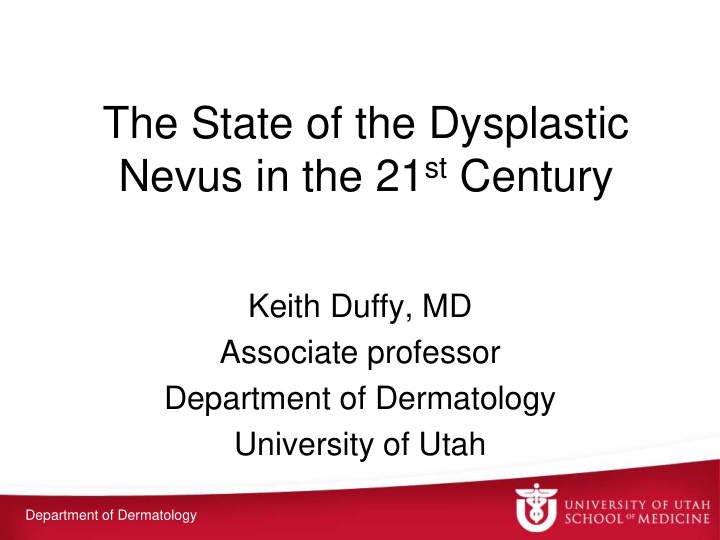



The State of the Dysplastic Nevus in the 21 st Century Keith Duffy, MD Associate professor Department of Dermatology University of Utah Department of Dermatology
Disclosures • Myriad Genetics – Advisory board; honorarium • Castle Biosciences – Advisory board; honorarium
What do I do? • Clinical – 60% Mohs micrographic and reconstructive surgery and high risk skin cancer – 40% Dermatopathology sign-out – Multidisciplinary cutaneous oncology program – Huntsman Cancer Institute • Administrative – Residency Program Director, Dermatology
Department of Dermatology
Department of Dermatology
The current(ish) state of affairs…
Do you believe dysplastic (Clark) nevi are truly premalignant lesions? 53% A. Yes B. No C. Unsure 25% 22% A. B. C.
How do you report “dysplastic nevi”? 62% A. Dysplastic nevus B. Clark nevus C. Nevus with architectural disorder 19% D. Other 12% 7% A. B. C. D.
Do you assign a histologic “grade” to these nevi? 87% A. Yes B. No 13% A. B.
If yes, what grading system do you use? A. Cytology as three grades (mild, moderate, 73% severe) B. Cytology and architecture as two separate grades C. Cytology as two grades 10% 10% 8% only D. Other grading system A. B. C. D.
Brief history • 1978 – Dr. Clark describes nevi associated with melanoma prone families – The B-K mole syndrome • 1978 – Dr. Lynch describes a single multi- generational family with melanoma and nevi – Familial atypical multiple mole melanoma syndrome (FAMMM)
Brief history • 1980 – Dr. Elder and Clark describe ‘ dysplastic nevi ’ in a non-familial setting – Introduction of the term ‘dysplastic nevus syndrome’ • Familial and sporadic variants • Formally postulated that ‘dysplastic nevi’ are precursors of melanoma
Dr. Wallace H. Clark, Jr.
The concept evolved… Dr. David Elder
When you are frustrated by the pathology report and management of these lesions please send all complaints to…
• Recommend abandoning the term “dysplastic nevus.” • Highlights melanoma risk is linked to high nevus counts and large nevus size Department of Dermatology
J Am Acad Dermatol 2015;73:513-4 J Am Acad Dermatol 2015;73:514-5 Department of Dermatology
• “Dysplastic nevi are benign neoplasms of melanocytes that are significant in relation to melanoma in 3 ways: as potential precursors, markers of increased risk, and simulants.” • “Dysplastic nevi are intermediate between common nevi and melanoma – clinically, microscopically and genomically .” • …in my opinion the term “mild dysplasia” should be abandoned.”
• “I believe that most so - called ‘severely dysplastic’ are either melanoma or melanoma in situ arising in a nevus.” • “I believe it would be reasonable to change the name ‘dysplastic’ nevus.” • “I do not believe the name ‘dysplastic’ nevus will change anytime soon.”
What is a dysplastic nevus?
Duffy K, Grossman D, J Am Acad Dermatol. 2012 Jul;67(1):1-16
Duffy K, Grossman D, J Am Acad Dermatol. 2012 Jul;67(1):1-16
Duffy K, Grossman D, J Am Acad Dermatol. 2012 Jul;67(1):1-16
Duffy K, Grossman D, J Am Acad Dermatol. 2012 Jul;67(1):1-16
Shea CR, Vollmer RT, Prieto VG, Correlating architectural disorder and cytologic atypia in Clark (dysplastic) melanocytic nevi, Hum Pathol 1999, 30:500-5
“I know one when I see one.” Duncan et. al. , J Invest Dermatol 1993 100:318S-321S Piepkorn et. al., J Am Acad Dermatol 1994,30:707-714 Weinstock et. al., Arch Dermatol 1997,133:953-958 Clemente et.al., 1991 Hum Pathol 22:313-319
Mutations in nevi • Common nevi have a high rate of BRAF V600E mutations • Sporadic dysplastic nevi appear to be enriched for NRAS and BRAF non-V600E mutations • Recurrent TERT promoter mutations in a significant portion of dysplastic nevi
Department of Dermatology
Department of Dermatology
Department of Dermatology
Cockerell et al. Medicine (2016) 95:40 Department of Dermatology
What do we do now?
Arch Dermatol. 2012 Feb;148(2):259-60 Department of Dermatology
The decision to re-excise moderately dysplastic nevi inverted from a minority (9%) to a majority (81%) as a function of positive margin status. Department of Dermatology
Department of Dermatology
Results • 467 moderately dysplastic nevi with positive histologic margins observed for >3 years – Median f/u 6.9 years • NO cases of cutaneous melanoma developed at those sites • 100 patients (22.8%) developed a cutaneous melanoma at a separate site
41 year old female left lower back 40x Do you think there is a TERT promoter mutation in this lesion? Department of Dermatology
100x Dx: Compound dysplastic nevus with moderate cytological atypia, narrowly excised Department of Dermatology
49 year old, left lower back 40x Department of Dermatology
Dx: Malignant melanoma, superficial spreading type, Breslow depth 0.32 mm 100x Department of Dermatology
Study results • 17,024 Total nevi • 8654 cases Clark nevi (50.8%) • 959 recommended for re-excision (11.1%) • 765 re-excised (79.8%)
Study results • Of those re-excised 765 – 621 no residual nevus (81.2%) – 123 identifiable benign component (16.1%) – 6 not classifiable as benign or malignant – 15 melanoma (2.0%) • 12 MIS • 3 superficially invasive
My dermatopathologic approach? • Less use of the term dysplastic nevus, Clark’s nevus or nevus with architectural disorder – Use of the terms ‘junctional or compound lentiginous nevus’ – Atypical junctional/compound melanocytic proliferation
How do I practice? • I never diagnose a lesion with moderate or severe dysplasia • In my estimate this is unfair to the clinician
How do I practice? • Make specific recommendations to the clinician on management of the lesion
Report example
Always another set of eyes… pair How do I practice? of expert eyes
Conclusions • Dysplastic nevi appear to be different histologically and genomically • Still… only a small number progress to melanoma – Which ones? – Will the genomic and personalized medicine revolution make our job better/easier/more conclusive?
Conclusions • We are still stuck in The (seemingly) Eternal Debate • Pigmented lesions are a team sport – Clinician concern – Concensus dermatopathology opinion – Photographs! • Molecular medicine is coming commercially to a lab near you
Thank you. Questions or comments? Keith.duffy@hsc.utah.edu
Recommend
More recommend